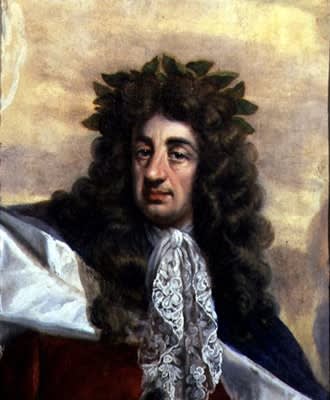
Antonio Verrio
To view all current artworks for sale visit philipmould.com
Verrio arrived in England in 1672, probably at the invitation of Ralph Montagu, later 1st Duke of Montagu. In 1675, by which time he had come to the attention of the King, Verrio had begun work on the newly constructed north range at Windsor Castle and was occupied on this gargantuan project, encompassing some 26 spaces or rooms, until about 1684, making it by far his most important commission.
Vertue records that the work was 'perform'd to the great satisfaction (King Charles 2d paid him Nobly for his workes here but being very lavish of his good Fortune the King also gave him a Gold Chain & Medal of great Value'. -1
Croft-Murray lists the individual schemes in detail, of which the most extensive and important were the decoration of St.George's Hall and the King's Chapel. 2 The King's Chapel comprised of a ceiling painting of the Ascension and Christ healing the sick, seen through a screen of twisting columns on the north wall; it also included an altarpiece of the Last Supper.
The paintings in St.George's Hall consisted of a main oval ceiling of Charles II in Garter robes enthroned, and attended by various allegorical figures, with the 1st Earl of Shaftesbury among the forces of Evil dispersing Libels. The subsidiary octagons showed the Star of the Garter surrounded by the Muses, and the Collar of the Garter, bordered by other allegorical figures. In the cove putti supporting Garter mantles. The north wall showed the Black Prince received in triumph by Edward III; the west wall feigned tapestry with St. George and the dragon; and on the east wall were two statues in niches and the inscription:
ANTONIO VERRIO NEAPOLITANUS
NON IGNOBILE STIRPE NATUS
AUGUSTISSIMI REGIS CAROLI SECUNDI
ET / SANCTI GEORGII
MOLEM HANC FAELICISSIMA MANU
DECORAVIT
The artist was paid £1050 for his work in the King's Chapel, between 1680-4 and £1250 for St George's Hall between 1682-4.
A drawing of undetermined status, relating to the design of the ceiling of St George's Hall, was recently acquired by the Royal Collection Trust (see attached photocopy). It clearly shows the central seated figure of Charles in Garter robes and wearing a laurel wreath on his head, being crowned by two allegorical figures. Sketches for the ceilings of both St George's Hall and the King's Chapel were recorded with Verrio's effects at Burghley, although the former is possibly the drawing in the Royal Collection. 3 Early nineteenth drawings of the interiors at Windsor, such as W.H.Pyne's Royal Residences (1820), clearly show the overall design of Verrio's decoration, but not in great detail.
Although all the painted decoration was believed to have been comprehensively destroyed in about 1824 during the remodelling of the castle for George IV by the architect Sir Jeffrey Wyattville, a number of fragments from other rooms were dismantled and preserved, although they do not appear to be contextually so significant. One fragment, a medallic portrait of Charles II in the Royal Collection (36 x 27 inches) may have belonged to the subject on the ceiling of the King's Presence Chamber, in which Mercury displays a portrait of Charles II to the four quarters of the earth.4 Alternatively it could be from the ceiling of Henry VIII''s Chapel, which showed the glorification of James II with Fame holding medallion portraits of Charles I and Charles II. This fragment was removed by Wyattville to his residence at Winchester Tower.
A second fragment in the Royal Collection which shares the same provenance is a portrait of William III (36 x 27 ins.) by Sir Godfrey Kneller. 5 This painting of William III enthroned was executed c. 1695-1700 on the west wall of St. George's Hall.
Another fragment by Verrio containing a portrait of King Charles II is at Packwood House (National Trust, 32 x 25 ins.). 6 It is inscribed on the reverse From the King's State Drawing Room Ceiling - a scheme depicting the Restoration of the Monarchy with the King riding across the sky in a chariot.
1. Vertue, Note Books, Volume II, The Walpole Society, Vol. XX (1932), p. 132.
2. E.Croft-Murray, Decorative Painting in England 1537-1837, Vol.1, 1962, p. 240-242.
3. Ibid.
4. O. Millar, Tudor, Stuart and Early Georgian Pictures, 1963, Text, No. 296, p. 132-133.
5. Ibid, No.336, pp. 142-143.
6. C. H. Collins Baker, Antonio Verrio and Thornhill's Early Portraiture, Connoisseur, Vol. CXXXI (1953), No. VI, p. 12.
Provenance
At Windsor Castle until c. 1824;Dorotheum Sale, Vienna, 6th March 1996, Lot 156 (as a portrait of Kaiser Leopold I by a follower of Jan Thomas)
Be the first to hear about our available artworks
* denotes required fields
We will process the personal data you have supplied in accordance with our privacy policy (available on request). You can unsubscribe or change your preferences at any time by clicking the link in our emails.